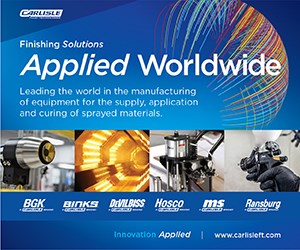More About Magnetic Separation
Last October's column about separation was limited to general parameters for deciding if you will hand separate or automatically separate parts from media.
Last October's column about separation was limited to general parameters for deciding if you will hand separate or automatically separate parts from media. This article provides more information on this underused process. It assumes you have already eliminated part-on-part processing and have determined that the parts are of a size and material that can reasonably be picked up with a magnet.
Before going too far with this subject, be forewarned that handling ferrous parts with a magnet leaves some residual magnetism in the parts. A unit of magnetic energy is called a gauss, named after the German astronomer, Karl Gauss, who first quantified it around 1880. Hand-held gaussmeters are inexpensive and a worthwhile investment before you start magnetic separation in your shop. Why bother? Because magnetized parts can be difficult to handle later and, if the parts are to be plated, magnetism is a definite "no-no." De-magnetizing is accomplished by passing the parts through a degaussing ring, usually an integral part of the equipment. Simple, but essential.
Hand-held magnets are the simplest devices for magnetic separation. They are very useful with small tub style machines up to about 3 ft3 or with bowl machines, perhaps as large as 10 ft3. You may want one of these in the finishing department regardless of other equipment available.
All mass finishing machines can be configured for at least semi-automatic magnetic separation systems. First, let's consider round vibratory machines. These are fairly easy to configure for the process without removing the workload from the machine. One approach is to have either a permanent or temporary partial dam so that the load will go up and over the dam. This action reduces the depth of the load at the top of the dam, and that is where the magnetic pickup will be most effective. The machine may actually contain some or all of the components for internal screen separation, including an automatically actuated dam, so that time cycles can be automated. It is easier to raise the load close to a magnetic drum, than it is to raise and lower the magnet.
Another advantage to using the internal separation apparatus with a magnetic separator is that the screen deck can be used for removal of undersized media - a process that is never accomplished with magnetics alone. A screen device for doing this can discharge undersized media out the side of the bowl. Keep this in mind if you have lodging problems caused by undersized media.
Also available are magnetic drum pickers that operate in line with a radial of the bowl, reaching over the side and lowering down to the mass. These systems have not enjoyed as much success as the style used in conjunction with an internal dam. The problem is usually that the mass has to make many passes by the magnet to get all the parts out, and stragglers remain from one load to the next.
Tub style vibrators are automated with external magnetic separators. Round vibrators can also use external devices. All the parts and media are unloaded through the discharge door where a conveyor and drum magnet take over. You should be aware, however, that tub and bowl batch vibratory machines seldom unload all of the mass without operator intervention.
Through-feed vibratory machines are easily adaptable to magnetic separation. All the components for returning the media to the machine are already in place. A magnetic approach here may reduce noise, parts damage and carryout of media.
Systems have been designed for centrifugal disc machines, centrifugal barrels, conventional barrels, open top barrels and all styles of through-feed mass finishers. The degree of automation will dictate the design and greatly impact the overall investment cost.
Simple, stand-alone systems are also available and very useful. They are separately operated and can service the loads from multiple mass finishing machines. These systems generally consist of a conveyor to take the parts and media under a magnetic drum. Media continues past the drum and into a hoist pan. Parts are transferred from the drum to a second conveyor that passes through the degausser.
Magnetic separation can be simple or complex. The important thing is to know it is an option when you are faced with separating parts from media. The finishing equipment manufacturers can help with the design of the right system when you are buying new equipment, and there are also good after-market suppliers to meet the need.
Read Next
Episode 45: An Interview with Chandler Mancuso, MacDermid Envio Solutions
Chandler Mancuso, technical director with MacDermid Envio discusses updating your wastewater treatment system and implementing materials recycling solutions to increase efficiencies, control costs and reduce environmental impact.
Read MoreEducation Bringing Cleaning to Machining
Debuting new speakers and cleaning technology content during this half-day workshop co-located with IMTS 2024.
Read MoreA ‘Clean’ Agenda Offers Unique Presentations in Chicago
The 2024 Parts Cleaning Conference, co-located with the International Manufacturing Technology Show, includes presentations by several speakers who are new to the conference and topics that have not been covered in past editions of this event.
Read More





















